- Details
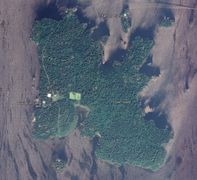 The Nature Conservancy of Canada (NCC) is a non-profit organization that works to protect natural areas through securing properties and managing them for the long term, ensuring their ecological integrity. NCC is partnering with the City of Kenora, local residents, cottagers, and campers to protect 82 hectares (202 acres) on Town Island.
The Nature Conservancy of Canada (NCC) is a non-profit organization that works to protect natural areas through securing properties and managing them for the long term, ensuring their ecological integrity. NCC is partnering with the City of Kenora, local residents, cottagers, and campers to protect 82 hectares (202 acres) on Town Island.
- Details
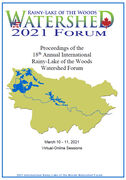 The Proceedings Report of the 2021 International Rainy-Lake of the Woods Watershed Forum is available for download at the Foundation’s website: lowwsf.com/forum-proceedings .Held March 10-11, via Zoom due to Covid-19, over 180 researchers, resource managers, policy makers and members of the public put Lake of the Woods and its watershed under the microscope. The report covers a wide range of subjects: including: watershed governance, aquatic invasive species, nutrients and algae, water regulation and monitoring.
The Proceedings Report of the 2021 International Rainy-Lake of the Woods Watershed Forum is available for download at the Foundation’s website: lowwsf.com/forum-proceedings .Held March 10-11, via Zoom due to Covid-19, over 180 researchers, resource managers, policy makers and members of the public put Lake of the Woods and its watershed under the microscope. The report covers a wide range of subjects: including: watershed governance, aquatic invasive species, nutrients and algae, water regulation and monitoring.
Most presentations were recorded and are available for viewing for a limited time at lowwsf.com/forum-presentations.
Please download a copy of the report or go to the website to view any presentation recordings that are of interest to you.
- Details
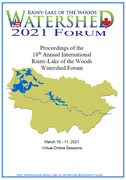 All eyes focused “virtually” on our watershed and lakes at the 18th annual International Rainy-Lake of the Woods Watershed Forum, held on March 10 and 11. Over 180 participated – a record attendance, with 21 presentations and Q&A sessions organized into theme groups of Water Governance, Aquatic Invasive Species, Nutrients, Canadian Phosphorus Options, Regulation, and Monitoring.
All eyes focused “virtually” on our watershed and lakes at the 18th annual International Rainy-Lake of the Woods Watershed Forum, held on March 10 and 11. Over 180 participated – a record attendance, with 21 presentations and Q&A sessions organized into theme groups of Water Governance, Aquatic Invasive Species, Nutrients, Canadian Phosphorus Options, Regulation, and Monitoring.
Priscilla Simard and Mona Gordon, Knowledge Keepers with the Women’s Council of Grand Council Treaty #3 opened the Forum with a prayer and ceremony honouring Nibi (water). Their thoughtful words, reflecting on the need to work together to respect and protect Nibi in our watershed, got our meetings and discussions started in a good way. Welcome addresses focusing on the strong binational collaboration in our watershed were provided by Consul General Ariel Delouya, from the Canadian Consulate in Minneapolis and Consul Brian Koontz, from the U.S. Consulate in Winnipeg.
- Details
By Bev Clark for the Lake of the Woods Water Sustainability Foundation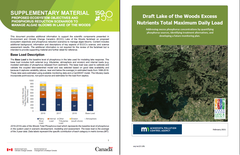 For many years now there has been a focus on determining the causes of nuisance algal blooms in Lake of the Woods. We know, based on a volume of scientific evidence, that too much phosphorus is the culprit, and this fact steers the question towards how much phosphorus is too much phosphorus? In order to answer this question, we need to determine:
For many years now there has been a focus on determining the causes of nuisance algal blooms in Lake of the Woods. We know, based on a volume of scientific evidence, that too much phosphorus is the culprit, and this fact steers the question towards how much phosphorus is too much phosphorus? In order to answer this question, we need to determine:
- How is phosphorus getting into the lake? and then,
- What are the effects of that phosphorus on the algal community?
- Details
By Bev Clark for the Lake of the Woods Water Sustainability Foundation I recently heard an ad for a major bank that claimed its products were the key to a sustainable future. I also remember when a patch of cattails in the corner of a parking lot was passed off as sustainable development. That was, at best, an effort towards lower impact development. Is there even such a thing as sustainable development? I tend to doubt it. Still, we need to think about sustainability with each management decision that we make and especially as it relates to ecosystem integrity.
I recently heard an ad for a major bank that claimed its products were the key to a sustainable future. I also remember when a patch of cattails in the corner of a parking lot was passed off as sustainable development. That was, at best, an effort towards lower impact development. Is there even such a thing as sustainable development? I tend to doubt it. Still, we need to think about sustainability with each management decision that we make and especially as it relates to ecosystem integrity.
- Details
By Bev Clark for the Lake of the Woods Water Sustainability Foundation. In my career as an Environmental Officer and later as a Scientist I have attended many public meetings where water levels were the primary issue. It is nearly impossible to make any gains at such a meeting because there are always exactly half of the people who want the water levels higher and exactly half that want them lower. Its all about the docks…right? OK so here’s the thing, although the regulatory agencies do consider multiple uses, the finer details are almost never about your dock.
In my career as an Environmental Officer and later as a Scientist I have attended many public meetings where water levels were the primary issue. It is nearly impossible to make any gains at such a meeting because there are always exactly half of the people who want the water levels higher and exactly half that want them lower. Its all about the docks…right? OK so here’s the thing, although the regulatory agencies do consider multiple uses, the finer details are almost never about your dock.
- Details
 This year’s workshop was a true testament to how we can adapt our engagement for the collective efforts on stewardship. On March 31st, 38 people came together on Zoom and worked together, with our two presenters, to discuss the most effective ways to engage citizens in science and stewardship. The lessons learned came from all over the watershed and involved a diverse range of passionate scientists, educators, lake users, and associations.
This year’s workshop was a true testament to how we can adapt our engagement for the collective efforts on stewardship. On March 31st, 38 people came together on Zoom and worked together, with our two presenters, to discuss the most effective ways to engage citizens in science and stewardship. The lessons learned came from all over the watershed and involved a diverse range of passionate scientists, educators, lake users, and associations.
- Details
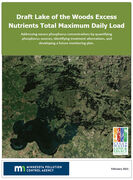 The health of Lake of the Woods also matters to our U.S. neighbours who share this important natural resource. The State of Minnesota, through the Minnesota Pollution Control Agency (MPCA), and the US EPA, under authorities in the Federal Clean Water Act, are also developing a plan for the lake's restoration including setting reduction targets for U.S. sources of phosphorus.
The health of Lake of the Woods also matters to our U.S. neighbours who share this important natural resource. The State of Minnesota, through the Minnesota Pollution Control Agency (MPCA), and the US EPA, under authorities in the Federal Clean Water Act, are also developing a plan for the lake's restoration including setting reduction targets for U.S. sources of phosphorus.
The Minnesota Pollution Control Agency’s draft Lake of the Woods Nutrient TMDL study will be on public notice from February 22, 2021 through March 24, 2021. The TMDL study is available on the MPCA’s website or can be found by searching online for “Lake of the Woods TMDL”.
Two virtual public information meetings will be held via Webex on March 4 from 1-3 p.m. and 6-8 p.m CST. Information meeting attendees will need to register to obtain a link to the meeting(s). Follow the links below to register for the meetings:
- LOWWSF remembers John Turner, a champion and great friend of Lake of the Woods
- Fourth Binational Lake Association Network Event in the books!
- Satellite Monitoring of Algal Blooms – Tools Now Available to Scientists and the Public
- Trent University Research Focuses on Phosphorus from Canadian Streams with Grant from LOWWSF
